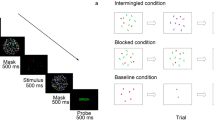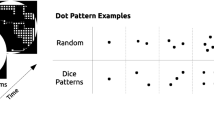Abstract
When people are presented with small sets of elements such as dots they can very easily determine their number. This ability has been called subitizing. The present paper reports results from four experiments. The discussion focuses on the question whether one or two psychological processes have to be assumed for this task of subitizing. Taken together our results support the two-process theories. In particular, a distinction between a process of separation and a process of enumeration is suggested. Experiments 3 and 4 support the canonical pattern hypothesis. Canonical patterns are processed substantially faster than noncanonical patterns. Furthermore, if a complex pattern can be broken down into small canonical patterns, then participants follow a partition and add strategy.
Similar content being viewed by others
Author information
Authors and Affiliations
Additional information
Accepted: 22 December 1999
Rights and permissions
About this article
Cite this article
Wender, K., Rothkegel, R. Subitizing and its subprocesses. Psychological Research Psychologische Forschung 64, 81–92 (2000). https://doi.org/10.1007/s004260000021
Issue Date:
DOI: https://doi.org/10.1007/s004260000021




